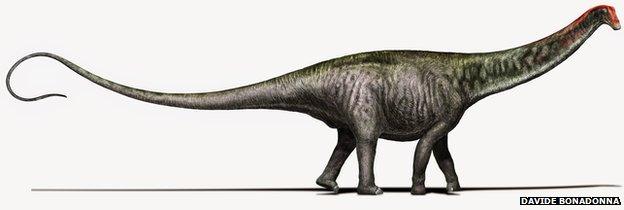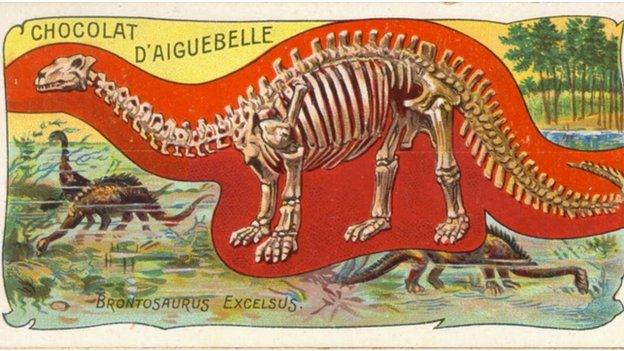Brontosaurus dino name is revived
- Published

The iconic name Brontosaurus, once used to describe a family of huge dinosaurs, has been resurrected after being killed off more than a century ago.
In 1903, scientists decided Brontosaurus was a more complete specimen of a different dinosaur.
But many more specimens of plant-eating sauropod dinosaurs are now known, revealing Brontosaurus to be different enough to warrant its own name.
The results have been published in the open access journal PeerJ, external.
The name Brontosaurus goes back to the so-called Bone Wars of the late 1800s, when rival fossil hunters Othniel Charles Marsh and Edward Drinker Cope raced new dinosaur names into the scientific literature.
In their quest for new specimens, Marsh and Cope were drawn to the rich fossil beds of the American west.
Marsh's team found two long-necked sauropods. He named one Apatosaurus ajax (Apatosaurus means "deceptive lizard") and the second skeleton Brontosaurus excelsus (Brontosaurus means "thunder lizard").
Shortly after Marsh's death, a team from the Field Museum of Chicago found another dinosaur skeleton similar to both Apatosaurus ajax and Brontosaurus excelsus, but with features deemed intermediate between the two. This led the scientists to conclude that Apatosaurus and Brontosaurus were just different species within the same scientific genus.
Apatosaurus took precedence because it had been named first so, Brontosaurus excelsus became Apatosaurus excelsus.

The fact that Brontosaurus had been reconstructed with the wrong type of skull did not help its case
But the name Brontosaurus is still known by several generations of schoolchildren. It's not entirely clear why the name stuck, but it may be to do with its origins in the Bone Wars, when there was intense public interest in the discovery of new dinosaurs.
It may also be because of the evocative meaning: "thunder lizard".
Now, Emanuel Tschopp from the New University of Lisbon in Portugal and colleagues applied statistical techniques to calculate the differences between species and genera of diplodocid dinosaurs (the large-scale grouping that includes Apatosaurus as well as other long-necked plant eaters).
It is only with new finds of dinosaurs similar to Apatosaurus and Brontosaurus in recent years that it became possible to undertake a detailed investigation of how different they were.
"Until very recently, the claim that Brontosaurus was the same as Apatosaurus was completely reasonable, based on the knowledge we had," said Mr Tschopp.
To their suprise, Brontosaurus emerged from the analysis as a distinct dinosaur.
The wrong skull
"The differences we found between Brontosaurus and Apatosaurus were at least as numerous as the ones between other closely related genera, and much more than what you normally find between species," explained Roger Benson, a co-author from the University of Oxford.
Thus, the researchers argue that it is now possible to resurrect Brontosaurus as a genus, different from Apatosaurus.
Prof Paul Barrett, of London's Natural History Museum, who was not involved in the research, told BBC News: "This paper is the most comprehensive study produced to date on the evolution of Diplodocus and its closest relatives and sets out some really interesting new ideas on how these animals are related, and how they should be classified.
"The author finds a number of ways in which the original specimens of Brontosaurus and Apatosaurus can be separated from each other and uses these to resurrect Brontosaurus as a separate entity.
"The conclusions seem entirely reasonable to me, as they are well argued and well supported, and it will be interesting to see how how quickly these suggestions are adopted by the community."
Marsh's case was not helped by making an incorrect reconstruction of Brontosaurus' skull because of the limited material available at the time. He had assumed it was boxy, like another long-necked dinosaur from the western US known as Camarasaurus.
But research in the 1970s showed that Apatosaurus - and thus "Brontosaurus" - would have had a slender, horse-like skull. This gave rise to a popular myth that "Brontosaurus" was simply an Apatosaurus with the wrong head.
Follow Paul on Twitter, external.